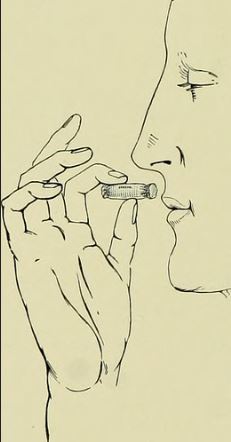A Ghost of Evil Odour

A Ghost of Evil Odour
I’ve been sniffing around the question of ghostly odors recently and, at the same time reading Joshua Cutchin’s A Trojan Feast and pondering Dr Beachcombing’s recent posts on boggarts, including one on Boggart Stones and Boggart Smells. In the account below we find ourselves in familiar territory: that of the shape-shifting Black Dog of the British Isles, but with an olfactory twist.
A GHOST OF EVIL ODOUR.
The same correspondent from Lucan has lately (1872) heard related, by a person well known to her, and on whose veracity she can rely, the following singular circumstance:—
There is a very lonely piece of road which was and is the high road for carriers travelling from Celbridge and Lucan to Dublin. Those carriers were usually employed by the farmers to carry in grain, potatoes, &c., and often brought home large sums of money. This road, even thirty years ago, was infested by robbers, who sometimes added murder to robbery. There were, in particular, two comrades in this horrible trade; also, there was a carrier who bore the character of being a regular profligate. This man, one night, was waylaid and murdered by those two wretches, and ever after the road where he was found was reported to be haunted, and very often the spirit appeared as a black calf of gigantic size, sometimes as a black dog, sometimes as a man, but always black. The odour also that proceeded from him was so overpowering that it caused vomiting, and in some cases the person who saw the ghost pined and died. One day a young woman (the sister of the narrator of this to our correspondent) was obliged to go to an uncle who lived at some distance, for money to meet a bill. She was desired on no account to remain out all night, and her brother, who had gone to a fair, promised to meet her on the road, just near the haunted spot. She was a bold, fearless woman, who did not trouble herself at all about the supernatural. It was rather late in the evening when she left her uncle’s house, with the money carefully tied in a handkerchief, the uncle having in vain entreated her to remain until morning. Having proceeded some distance, she perceived the form of a man coming towards her on the opposite side of the road. He was sauntering like a person waiting for some one. She at once concluded that this was her brother coming to meet her. As soon as the figure appeared to catch sight of her he crossed the road rapidly, stopping in front of her. She then became alarmed, perceiving that the figure was much taller than her brother, and thinking that this was a robber. Raising her eyes to his face, she at once recognised who the figure was; still she did not lose her self-possession. He clutched her arm, and seemed as if to boil with evil passions. She adjured him in the name of the Blessed Trinity to say what he wanted of her. Immediately he let her go and vanished. She then went on to the next house, where, as it happened a girl was dying from the effects of having seen this phantom, and eventually this woman also died. Nor did the mark of black bruises, as if caused by the clutch of fingers and a thumb, ever leave her arm.”
The Spiritual Magazine, 1873: p. 263-64
So many paranormal motifs packed into a relatively short account! The bogey who morphs from calf to Black Dog to man; a ghost whose very appearance dooms the viewer; the Devil in the road; those ghastly supernatural fingermarks we all know and love from stories such as “The Black Velvet Band.”
I was particularly interested in the evil stench that made onlookers vomit. Joshua Cutchin, in A Trojan Feast, mentions Sasquatches who generate the same emetic odor. He also adds some intriguing parallels with those who ingest the vomitous shamanic drug, ayahuasca and alien contactees given purgative liquids. I would add that nauseating stenches are also reported as a feature of demonic possession and during sulphurous visits from the Devil. I’m trying to recall whether bad smells accompany any Black Dogs. Rather surprisingly, nasty ghostly odors are rarer in the paranormal literature than the more usual séance-room perfumes and fruit scents, although Elliott O’Donnell never met a foetid odour he didn’t like.
Was it the smell, like a kind of charnel-house chemical warfare, that made some of the ghost’s witnesses pine and die? Or was it the shock of encountering the horror on the road? “Pine” suggests PTSD and a slow decline. Why wasn’t the spirit equally (or immediately) lethal to all who saw it?
Theories or other sick-making phantom odors to chriswoodyard8 AT gmail.com
For other posts on malodorous spirits see A Ghost With the Smell of a Charnel House and The Consumption Letters: Decomposing Correspondence.
Chris Woodyard is the author of The Victorian Book of the Dead, The Ghost Wore Black, The Headless Horror, The Face in the Window, and the 7-volume Haunted Ohio series. She is also the chronicler of the adventures of that amiable murderess Mrs Daffodil in A Spot of Bother: Four Macabre Tales. The books are available in paperback and for Kindle. Indexes and fact sheets for all of these books may be found by searching hauntedohiobooks.com. Join her on FB at Haunted Ohio by Chris Woodyard or The Victorian Book of the Dead. And visit her newest blog, The Victorian Book of the Dead.
